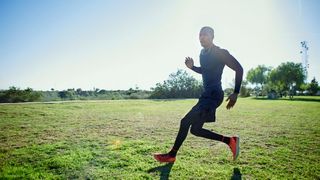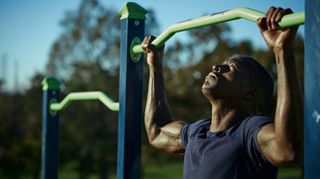Outdoor Fitness Training Plan
Don’t like the gym? No problem. Whatever your aim, we’ve assembled a go-anywhere training plan to build the body you want

In This Series
- Outdoor Fitness Training Plan
- Press-Ups Circuit
- Core Workout
- Sprint Training
- Fitness Challenges
So: you’re economising in an attempt to reduce the personal impact of the post-Brexit financial meltdown. Or maybe you’ve got a lovely park near you and spend most of your time at a desk so you wouldn’t mind getting an occasional glimpse of that big ball of fire in the sky. Or you’re allergic to mirrors. All entirely valid reasons to shift your workout away from the gym – but if that isn’t enough, consider that one recent investigation saw 800 people report reduced levels of stress and anger from training outside, while another study linked it with increased energy.
And apart from fresh air and oxygen prompting the release of feelgood hormone serotonin, there are other benefits. Five to 30 minutes of sun exposure at least twice a week will improve your body’s vitamin D levels, helping you build stronger bones and a more robust immune system.
Of course, dumbbells and squat racks can be hard to find outdoors, but that’s no obstacle. “With a bit of improvisation, you can mimic any workout you’d do in the gym outside,” says trainer David Jackson of the School of Calisthenics. “So if you don’t like the gym, there’s really no excuse.”
Even if you do like the gym, it’s still worth popping your shades on and your shirt off and hitting the grass for a workout now and then. See you in the park.
RECOMMENDED: Outdoor Fitness Classes in London
Mobility Training

Mobility training: it’s the new stretching. And the good news is using a select handful of dynamic movements won’t just improve your range of motion – it’ll get your circulation going and challenge your co-ordination. Forget doing an hour of yoga, just borrow a variation on the classic sun salutation. “Think of this as a slow-motion burpee,” says trainer Rannoch Donald. “It engages almost every muscle while providing a fantastic stretch.”
RECOMMENDED: Mobility Training Home Workout
Get the Coach Newsletter
Sign up for workout ideas, training advice, reviews of the latest gear and more.
The Aim A full-body warm-up that increases flexibility, sharpens mental focus and sets you up for a successful training session.
Why “Do this three or four times a week, and you’ll see your hip, ankle and knee range of motion improve,” says Donald. “Even if you don’t want to squat or do Olympic lifts, that’s certain to improve your quality of life.”
How
- Start with your feet just wider than shoulder-width apart, toes pointing forwards.
- Squat down by bending at the knees and hips and place your hands between your feet.
- Move your left foot backwards so you’re in a lunge position.
- Move your right foot back to assume a press-up position with your body in a straight line.
- From here, drop your hips to the floor while keeping your arms straight. This position is the traditional yoga “cobra”.
- Hold the cobra position for a second, then raise your hips, do one press-up, and reverse the whole move until you’re standing up.
- Do one rep, take one breath, then repeat for two, three and four reps and breaths. Rest for a minute, then repeat. You’re ready to start your workout.
Calisthenics Workout
Fancy hitting the jungle gym, but worried that everyone else there will be doing shirtless human flags? Don’t be. “Everyone’s talking about calisthenics at the moment, but a lot of the conversation is directed at advanced movements,” says Tim Stevenson of the School of Calisthenics. “Everything is built on the basics. Week-to-week calisthenics programmes largely focus on building strength, muscle and skill by using variations of a few staple exercises – ideal for those who want to start but feel intimidated by the perceived ‘impossibility’ of some of the harder exercises.” Do these workouts once a week each for a month, and you’ll be ready to graduate to the hard stuff.

RECOMMENDED: An Introduction to Calisthenics Training
Pulling Power
The Aim Build back strength and improve posture with just a pull-up bar.
How Do the active hangs to warm up your shoulders, then do three to five sets of each pulling exercise, with 90 seconds of rest in between. As you improve, you can add an extra rep to each session, or reduce the amount of time you rest by ten seconds.
Why “Most people do some vertical pulling in their workout, but horizontal pulls are important for hitting the muscles from other angles, and are slightly less high-intensity,” says Stevenson. “This workout improves the strength and stability of the muscles that retract and depress the shoulder blade. All that means healthier, more robust shoulders.”
RECOMMENDED: Master the Pull-Up
Active hang
“Hanging is pretty simple but the real key is knowing the difference between a ‘dead’ hang and an ‘active’ hang,” says Stevenson. “In the dead hang you would be holding the bar but not creating any tension – you’re basically hanging on slack muscle and connective tissue. The active hang occurs when you pull the shoulder blades down and together as if you were squeezing a coin between them.” Do three sets of eight.
Rock climber pull-up
Start by hanging from a bar with your hands shoulder-width apart, palms facing away. Pull up, but pull slightly harder with one hand, so that your chin ends up close to one hand. “This is a great progression towards the full ‘typewriter’ pull-up,” says Stevenson.
Row
On a low bar, position your hands shoulder-width apart and walk your feet underneath so your body is in a straight line with your heels on the ground, at about 45°. Keeping your elbows close to your body, pull your chest to the bar, then lower under control. To make it easier move your feet backwards to change the body angle in the start position. Do ten reps.
Leg strength
The Aim Lower-body strength
How Do the below circuit two to four times, going for five to ten reps of each move, then finish with the sprints. Can’t manage that? Do one or two reps and work your way up.
Pistol squat
Stand on one leg and start the squat by sitting back and down as if going into a chair. Get stable at the bottom, then drive the foot hard into the ground and try to crack an imaginary walnut between your glutes on the way up.
Shrimp squat
Grab your right foot with your right hand and hold it against your glutes. Put your left arm out in front of you to help with balance and weight distribution. Squat down with your left leg until your right knee touches the ground. Keep your bodyweight forwards over the left foot. Push hard into the ground to stand back up.
Sprint
“Set out markers at ten, 20, 40 and 50 metres or try to train at a sports pitch where lines are marked out already,” says Stevenson. “Sprint to each line, recover by walking back, then sprint again to the next marker.” Do three sets.
From 2008 to 2018, Joel worked for Men's Fitness, which predated, and then shared a website with, Coach. Though he spent years running the hills of Bath, he’s since ditched his trainers for a succession of Converse high-tops, since they’re better suited to his love of pulling vans, lifting cars, and hefting logs in a succession of strongman competitions.

